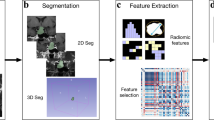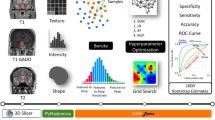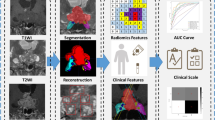Abstract
Purpose
To make individualised preoperative prediction of non-functioning pituitary adenoma (NFPAs) subtypes between null cell adenomas (NCAs) and other subtypes using a radiomics approach.
Methods
We enrolled 112 patients (training set: n = 75; test set: n = 37) with complete T1-weighted magnetic resonance imaging (MRI) and contrast-enhanced T1-weighted MRI (CE-T1). A total of 1482 quantitative imaging features were extracted from T1 and CE-T1 images. Support vector machine trained a predictive model that was validated using a receiver operating characteristics (ROC) analysis on an independent test set. Moreover, a nomogram was constructed incorporating clinical characteristics and the radiomics signature for individual prediction.
Results
T1 image features yielded area under the curve (AUC) values of 0.8314 and 0.8042 for the training and test sets, respectively, while CE-T1 image features provided no additional contribution to the predictive model. The nomogram incorporating sex and the T1 radiomics signature yielded good calibration in the training and test sets (concordance index (CI) = 0.854 and 0.857, respectively).
Conclusion
This study focused on the preoperative prediction of NFPA subtypes between NCAs and others using a radiomics approach. The developed model yielded good performance, indicating that radiomics had good potential for the preoperative diagnosis of NFPAs.
Key points
• MRI may help in the pre-operative diagnosis of NFPAs subtypes
• Retrospective study showed T1-weighted MRI more useful than CE-T1 in NCAs diagnosis
• Treatment decision making becomes more individualised
• Radiomics approach had potential for classification of NFPAs





Similar content being viewed by others
Abbreviations
- NFPAs:
-
Non-functioning pituitary adenomas
- NCAs:
-
Null cell adenomas
- CE-T1:
-
Contrast-enhanced T1-weighted
- SVM:
-
Support vector machine
- AUC:
-
Area under the curve
- ROC:
-
Receiver operating characteristic
- ICCs:
-
Inter-observer correlation coefficients
- mRMR:
-
minimum-Redundancy Maximum-Relevancy
- BIC:
-
Bayesian information criterion
- C-index:
-
Concordance index
- NRI:
-
Net reclassification improvement
References
Melmed S (2011) Pathogenesis of pituitary tumors. Nat Rev Endocrinol 7:257–266
Daly AF, Rixhon M, Adam C, Dempegioti A, Tichomirowa MA, Beckers A (2006) High Prevalence of Pituitary Adenomas: A Cross-Sectional Study in the Province of Liège, Belgium. J Clin Endocrinol Metab 91:4769–4775
Fernandez A, Karavitaki N, Wass JAH (2010) Prevalence of pituitary adenomas: a community-based, cross-sectional study in Banbury (Oxfordshire, UK). Clin Endocrinol 72:377–382
Asa SL, Ezzat S (2009) The pathogenesis of pituitary tumors. Annu Rev Pathol-Mech 4:97–126
Wass JAH, Reddy R, Karavitaki N (2011) The postoperative monitoring of nonfunctioning pituitary adenomas. Nat Rev Endocrinol 7:431–434
Greenman Y, Stern N (2009) Non-functioning pituitary adenomas. Best Pract Res Clin Endocrinol Metab 23:625–638
Jaffe CA (2006) Clinically non-functioning pituitary adenoma. Pituitary 9:317–321
Oruçkaptan HH, Senmevsim Ö, Özcan OE, Özgen T (2000) Pituitary adenomas: results of 684 surgically treated patients and review of the literature. Surg Neurol 53:211–219
Breen P, Flickinger JC, Kondziolka D, Martinez AJ (1998) Radiotherapy for nonfunctional pituitary adenoma: analysis of long-term tumor control. J Neurosurg 89:933–938
Hashimoto N, Handa H, Yamashita J, Yamagami T (1986) Long-term follow-up of large or invasive pituitary adenomas. Surg Neurol 25:49–54
AL-Mefty O, Kersh JE, Routh A, Smith RR (1990) The long-term side effects of radiation therapy for benign brain tumors in adults. J Neurosurg 73:502–512
Kanner AA, Corn BW, Greenman Y (2009) Radiotherapy of nonfunctioning and gonadotroph adenomas. Pituitary 12:15–22
Castinetti F, Régis J, Dufour H, Brue T (2010) Role of stereotactic radiotherapy in the management of pituitary adenomas. Nat Rev Endocrinol 6:214–223
Lambin P, Rios-Velazquez E, Leijenaar R et al (2012) Radiomics: Extracting more information from medical images using advanced feature analysis. Eur J Cancer 48:441–446
Aerts HJWL, Velazquez ER, Leijenaar RT et al (2014) Decoding tumor phenotype by noninvasive imaging using a quantitative radiomics approach. Nat Commun 5:4006–4013
Huang YQ, Liang CH, He L et al (2016) Development and validation of a radiomics nomogram for preoperative predicting lymph node metastasis in colorectal cancer. J Clin Oncol 34:2157–2164
Wu J, Aguilera T, Shultz D et al (2016) Early-stage non-small cell lung cancer: quantitative imaging characteristics of (18)F Fluorodeoxyglucose PET/CT allow prediction of distant metastasis. Radiology 281:270–278
Huang Y, Liu Z, He L et al (2016) Radiomics Signature: A Potential Biomarker for the Prediction of Disease-Free Survival in Early-Stage (I or II) Non-Small Cell Lung Cancer. Radiology 281:947–957
Shiradkar R, Podder TK, Algohary A, Viswanath S, Eills RJ, Madabhushi A (2016) Radiomics based targeted radiotherapy planning (Rad-TRaP): a computational framework for prostate cancer treatment planning with MRI. Radiat Oncol 11:148
Nie K, Shi LM, Chen Q et al (2016) Rectal cancer: assessment of neoadjuvant chemoradiation outcome based on radiomics of multiparametric MRI. Clin Cancer Res 22:5256–5264
White GH (1980) Skewness, kurtosis, and extreme values of northern hemisphere gerpotential heights. Mon Weather Rev 108:1446–1455
Haralick RM, Shanmugam K, Dinstein I (1973) Textural features for image classification. IEEE Trans Syst Man Cybern 6:610–621
Soh LK, Tsatsoulis C (1999) Texture analysis of SAR sea ice imagery using gray level co-occurrence matrices. IEEE T Geosci Remote 37:780–795
Clausi DA (2002) An analysis of co-occurrence texture statistics as a function of grey level quantization. Can J Remote Sens 28:45–62
Galloway MM (1975) Texture analysis using gray level run lengths. Comput Graph Image Process 4:172–179
Chu A, Sehgal CM, Greenleaf JF (1990) Use of gray value distribution of run lengths for texture analysis. Pattern Recogn Lett 11:415–419
Peng HC, Long FH, Ding C (2005) Feature selection based on mutual information: criteria of max-dependency, max-relevance, and min-redundancy. IEEE T Pattern Anal 27:1226–1238
Baharad E, Nitzan S (2003) The borda rule, condorcet consistency and condorcet stability. Economic Theory 22:685–688
Mehmood T, Liland KH, Snipen L, Sæbø S (2012) A review of variable selection methods in partial least squares regression. Chemometr Intell Lab 118:62–69
Chang CC, Lin CJ (2011) LIBSVM: a library for Support Vector Machines. ACM Intel Syst Tec 2:1–27
Schaller B (2003) Gender-related differences in non-functioning pituitary adenomas. Neuroendocrinol Lett 24:425–430
Feng J, Hong LC, Wu YG et al (2014) Identification of a subtype-specific ENC1 gene related to invasiveness in human pituitary null cell adenoma and oncocytomas. J Neuro-Oncol 119:307–315
Balogun JA, Monsalves E, Juraschka K et al (2015) Null cell adenomas of the pituitary gland: an institutional review of their clinical imaging and behavioral characteristics. Endocr Pathol 26:63–70
Terada T, Kovacs K, Stefaneanu L, Horvath E (1995) Incidence, pathology, and recurrence of pituitary adenomas: study of 647 unselected surgical cases. Endocr Pathol 6:301–310
Funding
This study has received funding by National Key Research and Development Program of China (2017YFA0205200, 2017YFC1308700, 2106YFC0103702, 2016YFA0201401, 2017YFC1308701, 2017YFC1309100, 2016CZYD0001), National Natural Science Foundation of China (81227901, 81527805, 61231004, 81501616, 81671851), Beijing Municipal Science & Technology Commission (Z161100002616022, Z171100000117023), the Science and Technology Service Network Initiative of the Chinese Academy of Sciences (KFJ-SW-STS-160), the International Innovation Team of CAS (20140491524), the Instrument Developing Project of the Chinese Academy of Sciences (YZ201502) and National High Technology Research and Development Program of China (2015AA020504).
Author information
Authors and Affiliations
Corresponding authors
Ethics declarations
Guarantor
The scientific guarantor of this publication is Jie Tian.
Conflict of interest
The authors of this manuscript declare no relationships with any companies, whose products or services may be related to the subject matter of the article.
Statistics and biometry
Dr. Di Dong from the University of Chinese Academy of Sciences, who is one of the authors, has significant statistical expertise.
Informed consent
Written informed consent was waived by the Institutional Review Board of Beijing Tiantan Hospital Affiliated to Capital Medical University.
Ethical approval
Institutional Review Board approval was obtained.
Methodology
• retrospective
• diagnostic or prognostic study
• performed at one institution
Electronic supplementary material
ESM 1
(DOCX 265 kb)
Rights and permissions
About this article
Cite this article
Zhang, S., Song, G., Zang, Y. et al. Non-invasive radiomics approach potentially predicts non-functioning pituitary adenomas subtypes before surgery. Eur Radiol 28, 3692–3701 (2018). https://doi.org/10.1007/s00330-017-5180-6
Received:
Revised:
Accepted:
Published:
Issue Date:
DOI: https://doi.org/10.1007/s00330-017-5180-6




